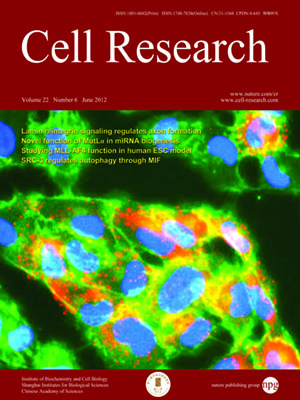
Volume 22, No 6, Jun 2012
ISSN: 1001-0602
EISSN: 1748-7838 2018
impact factor 17.848*
(Clarivate Analytics, 2019)
Volume 22 Issue 6, June 2012: 1046-1057
ORIGINAL ARTICLES
Arabidopsis STO/BBX24 negatively regulates UV-B signaling by interacting with COP1 and repressing HY5 transcriptional activity
Lei Jiang1,3, Yan Wang2, Qian-Feng Li3, Lars Olof Björn1, Jun-Xian He3 and Shao-Shan Li1
1Key Laboratory of Ecology and Environmental Science in Guangdong Higher Education, School of Life Science, South China Normal University, Guangzhou, Guangdong 510631, China
2College of Life Science and Technology, Jinan University, Guangzhou, Guangdong 510632, China
3State Key Laboratory of Agrobiotechnology and School of Life Sciences, The Chinese University of Hong Kong, Shatin, New Territories, Hong Kong SAR, China
Correspondence: Jun-Xian He, Shao-Shan Li,(jxhe@cuhk.edu.hk; lishsh@scnu.edu.cn)
UV-B (280-315 nm) is an integral part of solar radiation and can act either as a stress inducer or as a developmental signal. In recent years, increasing attention has been paid to the low-fluence UV-B-induced photomorphogenic response and several key players in this response have been identified, which include UVR8 (a UV-B-specific photoreceptor), COP1 (a WD40-repeat-containing RING finger protein), HY5 (a basic zipper transcription factor), and RUP1/2 (two UVR8-interacting proteins). Here we report that Arabidopsis SALT TOLERANCE (STO/BBX24), a known regulator for light signaling in plants, defines a new signaling component in UV-B-mediated photomorphogenesis. The bbx24 mutant is hypersensitive to UV-B radiation and becomes extremely dwarfed under UV-B treatment. By contrast, BBX24 overexpression transgenic lines respond much more weakly to UV-B than the bbx24 and wild-type plants. BBX24 expression is UV-B-inducible and its accumulation under UV-B requires COP1. Co-immunoprecipitation experiments indicate that BBX24 interacts with COP1 in planta upon UV-B illumination. Moreover, BBX24 interacts with HY5 and acts antagonistically with HY5 in UV-B-induced inhibition of hypocotyl elongation. Furthermore, BBX24 attenuates UV-B-induced HY5 accumulation and suppresses its transcription-activation activity. Taken together, our results reveal a previously uncharacterized function of the light-regulated BBX24 in UV-B responses and demonstrate that BBX24 functions as a negative regulator of photomorphogenic UV-B responses by interacting with both COP1 and HY5. The UV-B-inducible expression pattern and its suppression of HY5 activity suggest that BBX24 could be a new component of the feedback regulatory module of UV-B signaling in plants.
Cell Research (2012) 22:1046-1057. doi:10.1038/cr.2012.34; published online 13 March 2012
FULL TEXT | PDF
Browse 2462


